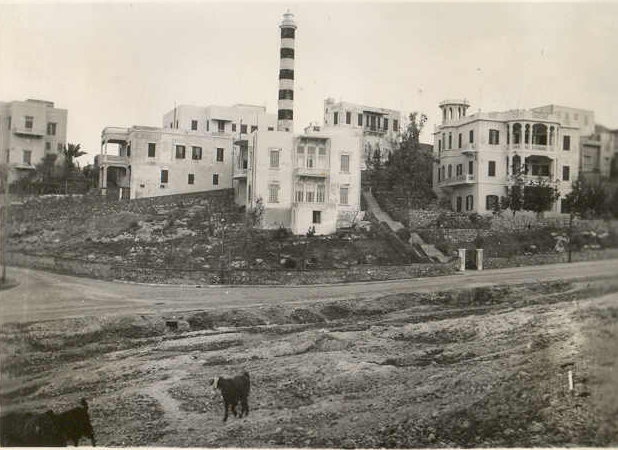 |
| Beirut 1925 |
The public sector in Beirut is weak, to say the least. Services and resident rights are, if extant, unprotected or inoperative. Yet some fragments of the citys builtscape remind us that the public sphere has at one point manifested iteself spatially in the city. Today, these spaces remain empty, unused or awaiting their demise.
The narrative of the old manara is a case in point. As a child living in its surroundings it always intrigued me. The black and white stripes, which seemed to climb up to the sky and project beams of light to guide vessels, I could never see in the waters, was almost magical. No building in the direct vicinity of the lighthouse on the hill could be constructed that would interrupt its projective abilities.
However, in 1995 Mr. Rabih Amish, a private developer, was given permission to construct an 18-floor building in the Al Manara area. The outcome would leave a wall in front of Beirut’s lighthouse destroying its functionality.
This event, which destroyed public infrastructure in the interest of private beneficiaries became a symbol of the Lebanese government’s demise.
The following is a photo essay depicting the nearlly 200 year old monument’s transformation on Beirut's seafront.
 |
| The first lighthouse in this location was built by the Ottoman Empire in 1825. This picture taken in 1895 is of the evolved lighthouse of the 1820s |
 |
| Closeup picture of the lighthouse built with stone, 1914 |
The Lighthouse, early 1900s, was shut during WW1 and was functional again in 1918
 |
| The lighthouse strategically constructed on a hill facing the coast was placed under the French control . 1920 |
 |
| This picture shows the relationship of the lighthouse to the sea and the coastlines topography |
 |
| The second Lighthouse seen here is built higher next to the first one . once the construction was completed the first lighthouse was brought down. picture 1928 |
 |
| The lighthouse Beirut 1942 shows an activated waterfront right before the Lebanese independence from the French |
 |
| Beirut 1942 the pedestrian urban staircase that takes you up to the lighthouse remains today as a functional pedestrian connection |
 |
Beirut Lighthouse 1962.
Here we see the third and final reconstruction of the lighthouse. Constructed and completed during the presidency of
Camille Nimr Chamoun . |
 |
| Just before the start of the civil war 1974 |
 |
| During the civil war 1976 to 1990 in Lebanon the lighthouse was turned off |
 |
| In 1990 at the end of the civil war President Hrawe ordered the renovation of the lighthouse which was fully completed in 1993 |
 |
| in 1995 the building on the right of the lighthouse was given permission to construct an 18 floor building breaking the building law that prevented any building from blocking the light path f the lighthouse to the sea! |
 |
| A new lighthouse was built closer to the water. The structure is higher than the old lighthouse seen here in a picture I took 2012 |
A visit up to the Lighthouse:
 |
| through a household up we went |
 |
| to see the light fixture that once guided vessels deep in the sea |
 |
| then out to the balcony we went to look out |
 |
Today the lighthouse is for the city and no longer for the sea
Will it wake it up again? |





















Fascinating... Thank you!
ReplyDelete:) beautiful :)
ReplyDeletevery nice pictorial documentary :)
ReplyDeleteMany many thanks
ReplyDeleteHello, is there a mailing list for your blog? So that I may receive updates VIA email. Thanks!
ReplyDeleteHow sad to see the changes. I used to love walking about the neighborhood in the very early 1970's; classic Levant. I knew it was special even as a boy. Old Beirut was a gem.
ReplyDeleteFantastic, My family lived in the house at the top of the flight of stairs shown on your picture No. 10 the one with the goats in the foreground. That was in 1957. Many many happy memories!
ReplyDeleteWhat a drastic change. What a shame.
ReplyDeleteHello Nice blog.
ReplyDeleteI read your content that is very useful information for us. Thank you so much.
architecture firms in lebanon
Interesting comment from Thomas Windle. My family also lived nearby until about 1953. There was a narrow lane between our house and the lighthouse, and I still have clear memories of it, including the occasion when the Champolleon ran aground. I've just read a story about that event that 'confirms' my understanding then that the captain confused the lighthouse with some airport lights.
ReplyDelete